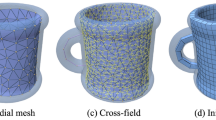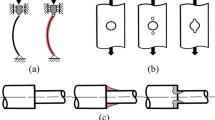Summary
This paper describes an approach that combines the volumetric decomposition suggestions and a pen-based user interface (UI) to assist in the geometry decomposition process for hexahedral mesh generation. To generate the suggestions for decomposition, a 3D medial object (MO) is first used to recognize and group sweepable regions. Second, each sweepable region of the original model is visualized using different colors. Third, the ideal cutting regions to create cutting surfaces are highlighted. Based on the visual suggestions, users then create cutting surfaces with the pen-based UI. The models are then decomposed into sweepable sub-volumes following the MO based suggestions. The pen-based UI offers three types of tools to create cutting surfaces: (1) Freeform based tool, (2) B-REP based tool, and (3) MO based tool. The pen-based UI also selects a suitable type of tool automatically based on users input. The proposed approach has been tested on industrial CAD models and hex meshing results are presented.
Access this chapter
Tax calculation will be finalised at checkout
Purchases are for personal use only
Preview
Unable to display preview. Download preview PDF.
Similar content being viewed by others
References
Yamakawa, S., Gentilini, I., Shimada, K.: Subdivision templates for converting a non-conformal hex-dominant mesh to a conformal hex-dominant mesh without pyramid elements. Engineering with Computers 27, 51–65 (2011)
Blacker, T.D., Meyers, R.J.: Seams and wedges in plastering: A 3D hexahedral mesh generation algorithm. Engineering with Computers 9, 83–93 (1993)
Hariya, M., Nishigaki, I., Kataoka, I., Hiro, Y.: Automatic hexahedral mesh generation with feature line extraction. In: Proceeding of the 15th International Meshing Roundtable, pp. 453–468 (2006)
Marechal, L.: A new approach to octree-based hexahedral meshing. In: Proceeding of the 16th International Meshing Roundtable, pp. 209–221 (2001)
Yamakawa, S., Shimada, K.: HEXHOOP: modular templates for converting a hex-dominant mesh to an all-hex mesh. Engineering with Computers 18, 211–228 (2002)
White, D.R., Tautges, T.J.: Automatic scheme selection for toolkit hex meshing. International Journal for Numerical Methods in Engineering 49(1-2), 127–144 (2000)
Quadros, W.R., Shimada, K.: Hex-layer: Layered all-hex mesh generation on thin section solids via chordal surface transformation. In: Proceeding of the 11th International Meshing Roundtable, pp. 169–182 (2002)
Price, M.A., Armstrong, C.G., Sabin, M.A.: Hexahedral mesh generation by medial surface subdivision: part I. solids with convex edges. International Journal for Numerical Methods in Engineering 38(19), 3335–3359 (1995)
Price, M.A., Armstrong, C.G.: Hexahedral mesh generation by medial surface subdivision: part II. solids with flat and concave edges. International Journal for Numerical Methods in Engineering 40(1), 111–136 (1997)
Simulia Corp., Abaqus product description, version 6.9, http://www.simulia.com/products/abaqus_fae.html
Sandia National Laboratories, Cubit 12.1 on-line user’s manual: web cutting, http://cubit.sandia.gov/help--version12.1/cubithelp.htm
Owen, S.J., Clark, B., Melander, D.J., Brewer, M.L., Shepherd, J., Merkley, K.G., Ernst, C., Morris, R.: An immersive topology environment for meshing. In: Proceeding of the 16th International Meshing Roundtable, pp. 553–577 (2007)
Lu, J.H.-C., Song, I.H., Quadros, W.R., Shimada, K.: Pen-based user interface for geometric decomposition for hexahedral mesh generation. In: Proceedings of the 19th International Meshing Roundtable, pp. 263–278 (2010)
Blum, H.: A transformation for extracting new descriptors of shape. In: Models for the Perception of Speech and Visual Form, pp. 362–380 (1967)
Quadros, W.: Extraction and applications of skeletons in finite element mesh generation. In: Proceeding of the 7th International Conference on Engineering Computational Technology (2010)
Lu, Y., Gadh, R., Tautges, T.J.: Feature based hex meshing methodology: feature recognition and volume decomposition. Computer-Aided Design 33(3), 221–232 (2001)
White, D.R., Saigal, S., Owen, S.J.: Ccsweep: automatic decomposition of multi-sweep volumes. Engineering with Computers 20, 222–236 (2004)
Shih, B.-Y., Sakurai, H.: Automated hexahedral mesh generation by swept volume decomposition and recomposition. In: Proceeding of the 5th International Meshing Roundtable, pp. 273–280 (1996)
Shih, B.-Y., Sakurai, H.: Shape recognition and shape-specific meshing for generating all hexahedral meshes. In: Proceeding of the 6th International Meshing Roundtable, pp. 197–209 (1997)
Ang, P.Y., Armstrong, C.G.: Adaptive curvature-sensitive meshing of the medial axis. In: Proceeding of the 10th International Meshing Roundtable, pp. 155–165 (2001)
Li, T.S., McKeag, R.M., Armstrong, C.G.: Hexahedral meshing using midpoint subdivision and integer programming. Computer Methods in Applied Mechanics and Engineering 124(1-2), 171–193 (1995)
Donaghy, R.J., Armstrong, C.G., Price, M.A.: Dimensional reduction of surface models for analysis. Engineering with Computers 16, 24–35 (2000)
Sampl, P.: Semi-structured mesh generation based on medial axis. In: Proceeding of the 9th International Meshing Roundtable, pp. 21–32 (2000)
Chong, C.S., Kumar, A.S., Lee, K.H.: Automatic solid decomposition and reduction for non-manifold geometric model generation. Computer-Aided Design 36(13), 1357–1369 (2004)
Sun, R., Gao, S., Zhao, W.: An approach to B-rep model simplification based on region suppression. Computers and Graphics 34(5), 556–564 (2010)
Quadros, W.R., Shimada, K., Owen, S.J.: Skeleton-based computational method for the generation of a 3D finite element mesh sizing function. Engineering with Computers 20, 249–264 (2004)
Author information
Authors and Affiliations
Editor information
Editors and Affiliations
Rights and permissions
Copyright information
© 2011 Springer-Verlag Berlin Heidelberg
About this paper
Cite this paper
Lu, J.HC., Song, I., Quadros, W.R., Shimada, K. (2011). Volumetric Decomposition via Medial Object and Pen-Based User Interface for Hexahedral Mesh Generation. In: Quadros, W.R. (eds) Proceedings of the 20th International Meshing Roundtable. Springer, Berlin, Heidelberg. https://doi.org/10.1007/978-3-642-24734-7_10
Download citation
DOI: https://doi.org/10.1007/978-3-642-24734-7_10
Publisher Name: Springer, Berlin, Heidelberg
Print ISBN: 978-3-642-24733-0
Online ISBN: 978-3-642-24734-7
eBook Packages: EngineeringEngineering (R0)




